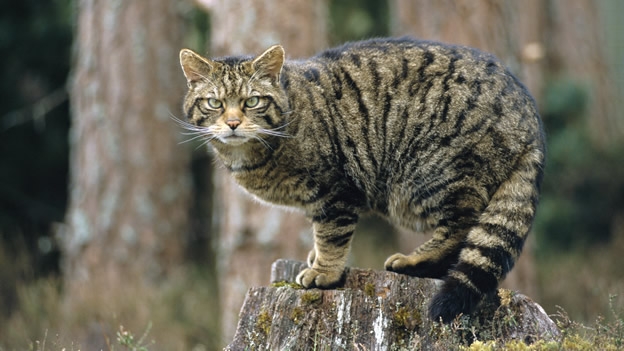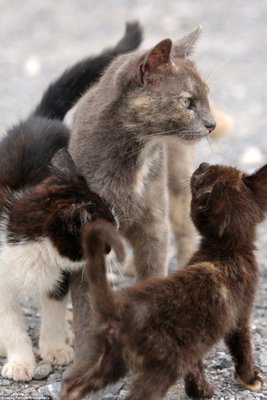Wild cats are tolerated better than dogs; they are generally clean animals, since they bury their feces, and nocturnal and elusive habits help it pass unnoticed for the majority of citizens. The presence of human food scraps, papers or containers left by some people, that represent a problem both for residents and for protective associations, Perhaps you have to consider this a problem of conduct human and not necessarily associated with the presence of animals
In some areas, especially in those residential, some habits of cats can be annoying: the marking of the males in mating season, the persecutions, fighting or the links can be a source that complaints neighborhood at certain times. Another factor to consider is the State of health of these animals. The permanent presence of animals sick or maimed are not tolerated because it is not "nice" view and forced neighbors to confront the consequences of certain behaviors are tolerated by society.,
The complaints come from, as a general rule, not by the presence of wild or stray cats, most of the citizenry understood as normal and everyday, but the increase of the same or greater perception when they become more visible by elimination of the sources of food. We are for a fact subjective, that is the number of cats in a concrete place tolerated until they begin the complaints.
C.E.S versus adoption
DO YOU 'CATCH-STERILISE-RETURN' TO THEIR ENVIRONMENT IS THE ULTIMATE SOLUTION TO PREVENT FELINE OVERPOPULATION?, AND 'CATCH-STERILISE-ADOPT' NON-CHANGING THING IS?
ADAPTED CAT: Literally, "not tamable cat". While these cats could be originally lost or abandoned domestic cats, that it is adapted to survive in the street in a regime of freedom, either cats already born of a naturalized mother, not just human contact. These cats in adult State can rarely become household, Despite the effort of months or years that engages them, and they will not easily support the captivity of domestic life.
They tend to live on the street, forming colonies, It is their social unit, living near a source of power and protection, and can survive anywhere where to find it, and virtually in the wild.
STRAY CAT: They tend to be cats that being domestic take to the streets and end up lost, or domestic cats that were abandoned. In this case, and given that in their day were pets, her chance of being socialized and given up for adoption is very high.
HOW DO WE DISTINGUISH ONE TYPE OTHER?
First of all, observe the appearance and behavior of the cat. The street We will probably approach, Although not enough as to be touched by us, and it may seem sociable with feeder, eating fast food that we put him in our presence, He even vocalizará the human with insistence to ask. You can have a scruffy appearance as if it were not accustomed to life on the street, and will be see at any time of the day.
On the other hand, adapted cat It is silent and will not approach strangers, and usually only stops to see from dusk to dawn, unless you are really hungry and look for food. These cats are adapted to live on the street and it will probably be good grooming; If we put food normally wait until we've gone to start eating it.
CAPTURE/STERILIZATION/RETURN (TNR): It is a not bloody feline populations reduction method, fast and long-term. It consists of performing massive programmes for Feral and stray cats in urban and rural areas, in order to be captured, revised sanitary, vaccinated and sterilized in a humanitarian manner and under strict veterinary control. Young and tame cats go to path of adoption, and feral cats will be returned to their habitat under the responsibility of their care by humans. Sick or injured cats that can cure, they will not be returned to your environment, and those without possible retrieval will humanely can.
The domestic cat, important role to play in our lives, He was born and lives in a wide range of circumstances, from pampered to the feral domestic cats, or free cats. In fact both are similar, Despite living in different environments, Since it is a same species, but the cat adapted is much closer to the wildlife in its pure State, only found in a habitat colonized by man, and he has learned to survive in freedom.
Many committed carers who invest lots of effort and time in attempting to find homes for Feral cats, with the intention to tame them. Unfortunately, This means consuming much time in a project with very few expectations of success. Even when a cat adapted "domestic", only manifest it with the caretaker that he took with him; very rarely with other human, or in other houses.
VAGRANCY IS NOT THE SAME AS THE ADAPTED STATE
A very common misunderstanding between caregivers and the general population, It is believe that cats that roam free are feral cats. In fact, among these we find the range: from domestic cats that come out of your House, to truly feral cats that live independent of humans.
THE DYNAMICS OF SOCIALIZATION
First and foremost, would have to consider the following question: why humans we feel impelled to take our home to feral cats, and why they resist our good intentions? Is it that they don't understand that we want their good, or is "our well designed them" what actually we pursue?
It is inherent to human nature (If it is not too sick to distort the trait), wanting to feed, protect and take care of other beings whose necessity we perceive, providing them with heat, safety and welfare. However, Despite being an admirable trait such sentiment, is not always an attitude appropriate for the adapted cat. The urge to withdraw from the street to feral cats It reflects on occasions our own need to be protected, and it is not the best for those cats, nor is it what the cats in question need. In general, these cats have lived their lives if more contact human - in the case of having that luck- that maintain it with your caregiver who fed and cared for in the colony. In the background of his instinct for survival, these cats include distrust of humans, and the apparent fear of confinement. A key element for your safety is their ability to flee when they perceive a danger.
Why is it that, even when we fed a cat adapted for a long time and it demonstrates confidence in its territory, This confidence can be seriously failed to be captive, and remove it forever. Be limited in the interior of a house or other closed place, It may be the most terrifying experience that has never had. It might seem that even us which eventually adapts or at least leaving Buffalo and unmanned, but you will never be comfortable or will no longer find a way to escape. On the other hand, captivity can damage the physical and mental health of the cat.
True adapted Cat House is the place where they were born and have grown up, where have they developed strong links between them and its territory, links that define its existence, for this reason, still being difficult to accept despite the bond that we have developed with them, It must be understood that own ties with other animals of their group and its territory, they are much stronger and more meaningful for your well-being. You can be in the interior of a House safe and warm, but outside are happier. His relationship with that medium and its social reference group, It is what most approaches them and develops its real nature.
Another reason that drives people to want to rescue the cats from the street is the belief that these animals live short, miserable lives, idea that has been maintained by too many groups, including some of the most important organizations in the country.
The reality is that the welfare of the cats is much more threatened as a result of their mating behaviors, births and inadequately litters, So what only the sterilization changes so radical this scenario, Since males cease fighting and wandering, and females stop having the servitude of parenting, the insecurity of their defence, that leaves them at the mercy of all kinds of vicissitudes; veterinary control ensures better protection and a higher level of health, and cats in colonies managed - in general- they can often reach live up to 10 years or more.
THE PASSAGE OF FEED TO PROTECT AND SANITIZE
The main element consists of socialization and adoption of abandoned adults and puppies. When puppies receive adequate care and individualized attention for eight weeks may in general be completely socialized to become domestic cats; accidentally separated from the mother pupfish, or that we are in a dangerous place, they will require to be bottle-fed every 3-4 HRS. At the same time, docile adults - cats who, for one reason or another, lost their home- they can often be resocializados and adopted, Therefore, in both cases, its reception and care is an invaluable contribution to the process, and it is certainly the best use of the resources available.
GREATER WELL-BEING FOR THE GREATEST NUMBER OF CATS
The objectives of the movement by the cats from the street, are:
– Change the mode in which feral cats are commonly treated in our country.
– Recognize their right to life and the place they occupy in the environment.
– Improve their conditions of life to the extent that we are able, especially through the application of the TNR.
All with the aim of focusing its existence from a humanitarian perspective, rather than extermination, as a means of reducing its population. In other words: Save and improve the lives of as many cats as possible.
Solve the problem of overpopulation through rescue and adoption, simply: is not possible. Feral cats multiply much more quickly of what we need to socialize them, and they are killed in shelters in a number far exceeding that are adopted. Even thinking that adoption is the most desirable route, There are no material resources to socialize and take to the tens of thousands who live in the country.
And do not forget that with the time and energy invested trying to socialize feral cats, thousands of abandoned cats and puppies can have an outlet for the adoption, having a real impact on the improvement of their lives.
The time to seriously examine the reasons that drive us to work on behalf of feral cats. With those caregivers only involved in your daily diet, you are an important part of this big stage, movement of street cats help already has twenty years of history in USA. If our ultimate goal is to achieve the well-being of the largest possible number of cats, the only way rational and humanitarian to get it is by applying the TNR, There is no other alternative, because every day are born more and more cats, and that's a fact of life.






